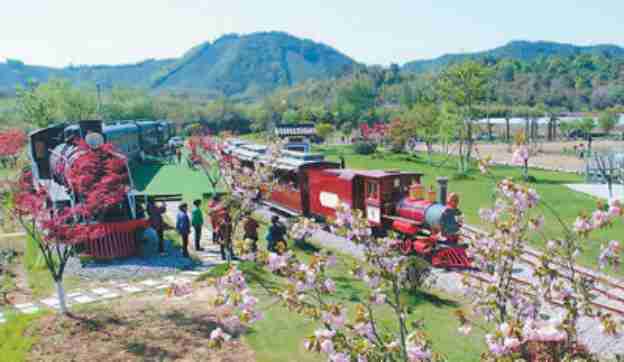

Anji county in east China’s Zhejiang province has been making continuous progress in its project to build beautiful villages, which will help boost rural tourism and increase villagers’ incomes.

A sightseeing railway line links 18 family farm scenic spots in Lujia village. (Photo/Xia Pengfei)
Anji took the nationwide lead in launching the project to build beautiful villages in 2008, and its guidelines for the project have been adopted as national standards, providing references for a range of places across China.
Chinese president Xi Jinping put forward the concept that “lucid waters and lush mountains are invaluable assets” in Yucun village in the county in 2005, emphasizing efforts to pursue green development.
While revisiting the village on March 30, Xi said that the vision of building a beautiful village has now become a reality in Yucun.
At the same time as ensuring a good ecological environment, Anji is making efforts to promote tourism and turn it into a new pillar of the economy.
Tourism is the primary solution for rural revitalization in Anji, said Peng Zhongxin, head of the county’s bureau of culture, sports and tourism.
Data shows that Anji was visited by over 28 million domestic and overseas tourists in 2019, and its revenues totaled 38.8 billion yuan.
In 2005, Pan Chunlin, a resident of Yucun village, started running an agritainment business, a form of farm-based tourism, which resulted in a massive wave of similar businesses in the village and the entire county.
By upgrading the business, Anji has boosted the development of integrated tourism, including homestays, high-end tourism complexes and signature towns over the past years. Thanks to its constant efforts, the county has been listed as one of the first national integrated tourism demonstration zones in China.
Another example is Lujia village. To turn it from a sewage-infested village into a beautiful one and improve the livelihoods of local villagers, Lujia implemented a comprehensive plan for rural, industrial and tourism development.
The village worked with tourism companies to transform itself into a scenic spot, through which villagers can increase their incomes via land rentals and bonuses from tourism revenues. Lujia also drew 2 billion yuan to build 18 separate family farms, where tourists can ride horses as well as harvest fruit and vegetable.
 Fire brigade in Shanghai holds group wedding
Fire brigade in Shanghai holds group wedding Tourists enjoy ice sculptures in Datan Town, north China
Tourists enjoy ice sculptures in Datan Town, north China Sunset scenery of Dayan Pagoda in Xi'an
Sunset scenery of Dayan Pagoda in Xi'an Tourists have fun at scenic spot in Nanlong Town, NW China
Tourists have fun at scenic spot in Nanlong Town, NW China Harbin attracts tourists by making best use of ice in winter
Harbin attracts tourists by making best use of ice in winter In pics: FIS Alpine Ski Women's World Cup Slalom
In pics: FIS Alpine Ski Women's World Cup Slalom Black-necked cranes rest at reservoir in Lhunzhub County, Lhasa
Black-necked cranes rest at reservoir in Lhunzhub County, Lhasa China's FAST telescope will be available to foreign scientists in April
China's FAST telescope will be available to foreign scientists in April "She power" plays indispensable role in poverty alleviation
"She power" plays indispensable role in poverty alleviation Top 10 world news events of People's Daily in 2020
Top 10 world news events of People's Daily in 2020 Top 10 China news events of People's Daily in 2020
Top 10 China news events of People's Daily in 2020 Top 10 media buzzwords of 2020
Top 10 media buzzwords of 2020 Year-ender:10 major tourism stories of 2020
Year-ender:10 major tourism stories of 2020 No interference in Venezuelan issues
No interference in Venezuelan issues
 Biz prepares for trade spat
Biz prepares for trade spat
 Broadcasting Continent
Broadcasting Continent Australia wins Chinese CEOs as US loses
Australia wins Chinese CEOs as US loses